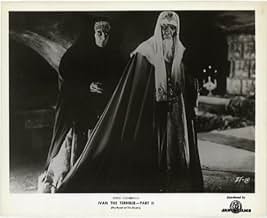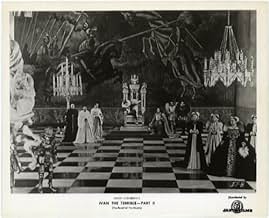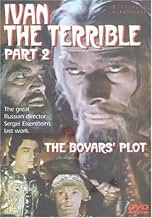Ivan, o Terrível - Parte 2
Após a morte de Anastasia, Ivan encontra-se sozinho na luta pela unificação da Rússia. Ao mesmo tempo que procura expulsar os invasores, o czar tenta ainda escapar das constantes tentativas ... Ler tudoApós a morte de Anastasia, Ivan encontra-se sozinho na luta pela unificação da Rússia. Ao mesmo tempo que procura expulsar os invasores, o czar tenta ainda escapar das constantes tentativas de assassinato levadas a cabo pelos seus inimigosApós a morte de Anastasia, Ivan encontra-se sozinho na luta pela unificação da Rússia. Ao mesmo tempo que procura expulsar os invasores, o czar tenta ainda escapar das constantes tentativas de assassinato levadas a cabo pelos seus inimigos
- Direção
- Roteirista
- Artistas
- Prêmios
- 1 indicação no total
- Nikolay the Fanatic
- (as V.I. Pudovkin)
- Elena Glinskaya, Ivan's Mother
- (as Ada Vojtsik)
- The Stranger
- (não creditado)
- Kaspar von Oldenbock, Livonian ambassador
- (não creditado)
Avaliações em destaque
The trials and tribulations surrounding the production and distribution of Ivan have become legendary in there own right. The film drew sharp criticism from Stalin and Eisenstein was forced to publicly announce his ''formalist errors.'' Subsequently, the film was banned in Russia until 1958 and Eisenstein was ostracized for what many saw as a film full of ''excess.'' It took many years before the world would come to realize it is nothing short of his greatest masterpiece.
A true cinematic realization of the ever elusive ''total work of art.'' A concept that originated with the Ancient Greeks and was further formulated by Richard Wagner in his epic masterwork, ''THE RING CYCLE.'' The Gestanmueack or ''intragel work of art'' as Wagner called it was in essence the synthesizing of every artistic medium into a single polyphonic experience. In the 20th century Eisenstein saw Wagner's music dramas as predecessors of cinema; a cinema that synthesized elements of all of mankind's arts into a single majestic, visceral and emotional experience which could transform and transfix the spectator. Together with the world renowned composer, master Sergei Prokofiev, and his lifelong cinematographer Eduard Tisse, Eisenstein labored for years researching and planning out every camera angle, lighting scheme, musical note, costume, color palette, gesture, and perspective; until every scene in Ivan becomes an intricate and complex world of its own. A world where actors twist and bend their forms to the limits of the plastic frame, shadows conceal and light reveals, the musical notes flow with the rhythm and tempo of the visual image and in the famous banquet scene, colors are used by Eisenstein to delve into the psychological states of the character's mind and state of being. It becomes a universe composed so precisely and diligently that every frame is infused with hidden metaphorical and symbolic meanings, and serves to create the epitome of cinematic achievement.
Tragically, like Schubert's great ''Unfinished Symphony'' or the Venus di Milo, Eisenstein passed away before completing the final part of his epic masterwork. What remains of Ivan the Terrible will live forever as a testament not only to the genius of Sergei Eisenstein but also to his unparalleled contribution to the world culture of the 20th century.
The story in Part Two picks up at a low point for Ivan, finding him with few friends and many problems. As the boyars begin to plot, there is less outward action than there was in Part One, but the drama is even tauter and the stakes even higher. The picture is also rounded out by the flashbacks to Ivan's youth, which give an even more complete picture of this complex ruler. (The English nickname 'terrible' does not really convey the full sense of his actual nickname in Russian.)
The early scenes lead up to the lengthy sequence of the banquet and its aftermath, which a masterpiece of psychological drama and effective film-making. The cat-and-mouse game between Ivan and his enemies is complemented by the color, imagery, and other details, and it all leads up to a climax filled with tension and possibilities.
Eisenstein's series on Ivan showcases the great Russian director's distinctive technique, and it is certainly one of the finest of all historically-based movies. With memorable characters, interesting stories, and lots of creativity, both movies are well worth multiple viewings - and this second part is even better than the first.
II begins exactly where I ends. Ivan has consolidated his power in Moscow, at least with the people (though not with the nobles, or "boyars"). In fact, what power he has inspires jealousy and fear in the boyars.
Ivan I builds Ivan up as a noble character. We despise the boyars for their flagrant wealth and greed, and we like Ivan for supporting the people. His closest comrades seem like Homeric heroes.
Ivan II develops Ivan's character even further. He may have power, but he still feels alone on the throne. His two greatest friends have left him, one gone to religion and one to the enemy. His immediate underlings, perceived as heroes in Ivan I, have grown paranoid and powerful. They convince Ivan to execute left and right. The only route for the boyars is to conspire Ivan's death.
Ivan II leads up to one of the single greatest climax I can think of. To heighten the effect, for the first time, Eisenstein opted to shoot in color. And as masterful as he was with black and white, he is also with color. The juxtaposition of color with black and white is absolutely amazing.
The only problem with the film is no one's fault. Part II ends, open for the third installment. Alas, Sergei Eisenstein would die before its completion. We're lucky enough to have Ivan the Terrible Part II, for Stalin demanded that it not be released theatrically, believing Ivan to be a portrait of himself. Eisenstein, in fact, never had the chance to see it released theatrically, was never to hear the lavish praise from critics the world round. Here I praise it, hoping that in the next world possibly Eisenstein can know what masterworks he made.
Você sabia?
- CuriosidadesThis film was withheld by Soviet authorities by order of Joseph Stalin, since this film, dealing with Ivan's slide into madness and the tyranny of the Oprichnina, did not properly mythologize Ivan IV Grozny to Stalin's satisfaction. It was not finally released until 10 years after the deaths of director Sergei Eisenstein and Stalin.
- Erros de gravaçãoIn the movie young Ivan IV is making a contract with the Livonian Brothers of the Sword. However it didn't exist since the 7th June 1238, almost 300 years before Ivan was born.
- Citações
Czar Ivan IV: From now on I will become the one you call me. I will become terrible.
- Cenas durante ou pós-créditosThe main cast and their roles is read by the narrator with accompanied footage.
- ConexõesFeatured in The Secret Life of Sergei Eisenstein (1987)
Principais escolhas
Detalhes
- Data de lançamento
- País de origem
- Idioma
- Também conhecido como
- Ivan the Terrible, Part II: The Boyars' Plot
- Locações de filme
- Empresas de produção
- Consulte mais créditos da empresa na IMDbPro
Bilheteria
- Faturamento bruto mundial
- US$ 1.655
- Tempo de duração1 hora 28 minutos
- Cor
- Mixagem de som
- Proporção
- 1.37 : 1

































